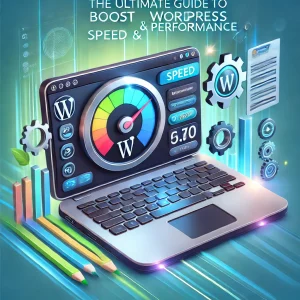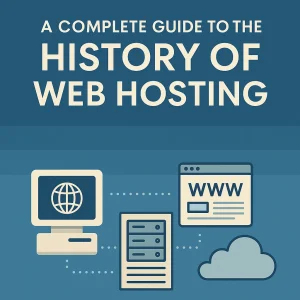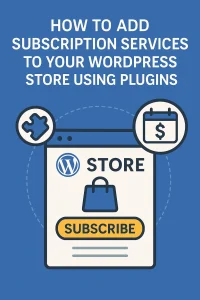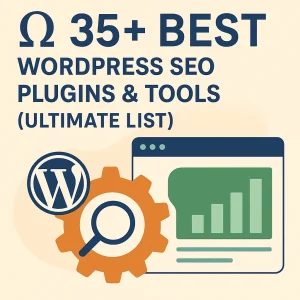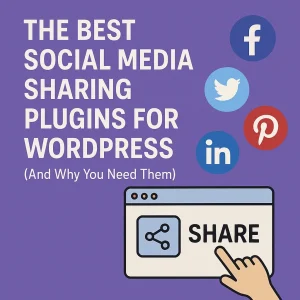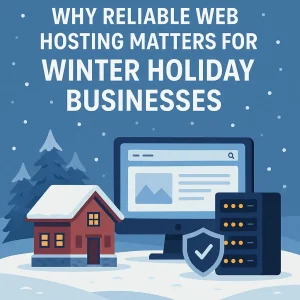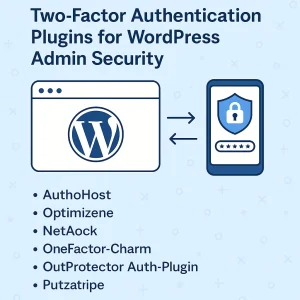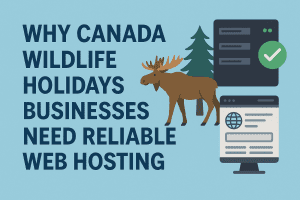Online users depend on fast website speed to access information and services. A website that takes too long to load makes users quit and stops them from visiting again. Research proves website speed matters because conversion rates decrease by 7% when users wait one second to see content. Businesses need to improve website loading speed because it helps both users and search engines rank their sites higher.
WordPress provides the most frequently used content management system software worldwide which manages about 40% of all internet websites. Although the platform provides many useful functions and adaptability it may slow down when users neglect its maintenance. Getting professional guidance helps you make the best choices to deliver a faster WordPress website experience. Having your WordPress site load speedily helps users experience better results and gains SEO benefits no matter what you use WordPress for.
Picking the proper hosting service plays the most powerful role in optimizing your WordPress platform's performance. The hosting service focuses on WordPress requirements to support users who work with that platform. Managed WordPress hosting brings automatic updates, daily backups and advanced security services that speed up your website performance. Our managed WordPress hosting solutions at 4GoodHosting were created to ensure fast website delivery.
Our guide shares 27 professional strategies to help your WordPress website run faster.
Why is site speed so important?
Google uses website speed as an important factor to determine a website's position. The speed of your website affects your search engine optimization results which decreases your chances of customers finding you. Fast loading websites build better user interactions that lead people to continue visiting your pages. A quality website setup lets servers handle large traffic increases without slowing down.
Our tutorial is here to show you how to boost your WordPress website speed. We will discuss 27 professional ways to boost your website speed in this detailed explanation. Managed WordPress web hosting makes performance better than standard web hosting options.
What Is Slowing Down My WordPress Site?
Here are the top reasons for slow WordPress sites:
- Inadequate web hosting: Low-quality hosting services limit server resources, leading to slow load times.
- Unoptimized or large images: High-resolution images increase page size and decrease download speed.
- Excessive or poorly coded plugins: Too many plugins or inefficient ones often cause performance issues.
- Heavy or bloated themes: Themes with excessive features or poor coding slow down your site.
- Lack of caching mechanisms: Without a cache, pages are generated dynamically each time, which increases load times.
- Not using a CDN: Without a CDN, users far from your server experience slower load times.
- Cluttered or unoptimized database: Data like revisions and spam accumulate in your database, slowing database queries.
- Too many HTTP requests: Multiple requests for files increase page load time.
- Loading external scripts and fonts: Fetching resources from external sites adds latency.
- Unminified CSS and JavaScript files: Large, uncompressed files take longer to load. How Do I Increase the Speed of My WordPress Site?
- Boost your WordPress site's speed with these proven strategies:
Optimize Your Hosting Environment
Your hosting environment is the foundation of your website's performance. An underpowered or poorly configured web server will bottleneck even the most optimized site. Choosing the right hosting provider and hosting plan is crucial for ensuring your site's speed, reliability, and scalability.
Here are the factors to consider when selecting a hosting provider and hosting plan:
- Specialized WordPress hosting: Choose hosting providers that specialize in WordPress. These hosts offer server configurations and support tailored specifically for WordPress, leading to improved performance and security. They also enable automatic updates.
- Server location: The geographical location of your server affects latency. Choose a data center geographically close to your target audience to minimize data travel time. Many hosting providers allow you to select your server location.
- Resource allocation. Ensure the host provides sufficient CPU power, RAM, and I/O resources to manage your site's traffic and processing needs. Review the hosting plan's specifications to confirm it meets your site's requirements, especially if you anticipate high traffic volumes.
- Dedicated hosting. Shared hosting multi-allocates sites on the same server so that any site may cause performance if it consumes too many resources. A Virtual Private Server or a dedicated server upgrade will always improve stability and speed.
- Managed hosting solutions. Managed WordPress hosting services handle server optimizations, caching, security updates, and backups on your behalf. With managed hosting, you can focus on your content and business without worrying about technical details.
- Scalable resources. Choose a hosting plan that can scale resources during traffic spikes to maintain site speed. Cloud hosting solutions offer scalable resources, ensuring your site remains fast even during high-traffic periods.
Optimize Images
Images enhance the visual appeal of your website but also significantly impact load times if not optimized. Optimizing images reduces page size, leading to faster load times without compromising visual quality. Here are some ways to optimize the images on your website:
- Use image optimization plugins : Install plugins like Smush or ShortPixel to automatically compress images upon upload. These tools reduce file sizes without noticeable loss of quality.
- Adjust compression levels: Balance image quality and file size by tweaking compression settings. Higher compression reduces file size but also affects image clarity.
- Perform bulk optimization: Compress existing images in your media library. Many plugins offer bulk optimization features to process all images at once.
- Use next-gen formats: Formats like WebP offer superior compression and quality compared to traditional ones like JPEG and PNG.
- Select the right formats: Use JPEG for photos, PNG for images that need to have transparency, and SVG for logos that will need to scale without losing quality.
Limit and Optimize Plugins
Plugins enhance your WordPress site's functionality but come at the cost of slowed performance. Every plugin adds code and database queries, which slow your site down if not optimized. Proper management of plugins is also important in ensuring the optimal speed and functioning of your site. Some tips on choosing the right plugins and not wasting resources are described below:
- Installed plugins auditing : Deactivate those that are no longer necessary, outdated or redundant.
- Avoid functionality overlap: Make sure plugins do not add features that are already covered by your theme or other plugins.
- Choose quality over quantity: It is better to have fewer plugins that are well-coded than a hundred that are not so well-coded.
- Research before installation: Check the rating, review, and frequency of updates.
- Use performance-orientated plugins: Use lightweight, performance-driven plugins like Yoast SEO and WP Rocket.
- Monitor plugin performance : Use tools like Query Monitor to identify plugins that consume excessive resources.
Use a Lightweight Theme
Heavy themes with extensive features and complex code slow down your site. Choosing a lightweight, well-coded theme is crucial for fast load times and efficient site operation. When selecting a theme, prioritize performance and simplicity:
- Minimalist themes. Select themes like GeneratePress or Astra that are designed for speed.
- Avoid feature bloat. Choose a theme that offers only the features you need.
- Responsive design: Ensure the theme is mobile-friendly and adapts to various screen sizes.
- Disable unused components: Turn off features you don't use, such as social media widgets.
- Optimize code :Remove or disable unused CSS and JavaScript files associated with the theme.
Implement Caching
Caching stores a version of your website's content, reducing server workload and speeding up page delivery. Proper caching drastically improves your site's load times. Here are two effective ways of implementing caching:
- Use a Caching Plugin ; Caching plugins simplify the process of setting up caching. Here are the ways caching plugins work:
- Page caching: Install plugins like WP Super Cache to generate static HTML pages of your dynamic content.
- Object caching: Use solutions like Redis to store database query results.
- Opcode caching : Ensure your server supports OPcache, which caches compiled PHP code.
Enable Browser Caching
Browser caching instructs visitors' web browsers to store certain files locally. To implement this solution, do the following:
- Set expiry headers: Configure your server to specify how long browsers should cache files like images and CSS.
- Leverage .htaccess. : For Apache servers, add caching rules to your .htaccess file to control caching behavior.
- Use plugins : Caching plugins often provide interfaces for setting cache durations and rules.
Use a Content Delivery Network (CDN)
A CDN improves site speed by distributing your content across a network of servers around the world. Implementing a CDN reduces latency, speeds up content delivery, and enhances user experience globally.
Setting up a CDN involves integrating it with your WordPress site:
- Choose a CDN provider: Consider providers like Cloudflare or Amazon CloudFront.
- Integrate with WordPress: Use plugins like CDN Enabler to connect your site to the CDN.
- Configure CDN settings: Decide which files to serve via the CDN, typically static assets like images and CSS files.
Update WordPress Core, Themes, and Plugins
Keeping your WordPress installation, themes, and plugins up to date ensures you benefit from the latest performance improvements and security patches. Conversely, outdated software causes performance issues, slows down your site, and exposes it to security vulnerabilities.
Here is a routine for managing updates:
- Enable automatic updates for minor releases and security updates. This step ensures that critical updates are applied immediately without manual intervention.
- Regularly check for updates: Manually update themes and plugins. Doing so ensures you’re using the latest features and performance improvements.
- Backup before updating: Always back up your site before significant updates. Having a comprehensive backup strategy protects your data in case the update causes conflicts or issues with your site’s functionality.
Use the Latest PHP Version
PHP is the power driver of WordPress. New versions come with considerable performance improvements, and upgrading to the stable version of PHP can help increase the speed of your website. However, you need to make sure your website is compatible and ready for the PHP update.
Here's how you apply the latest PHP version:
- Check compatibility: you can use some plugins that scan your themes and plugins to check compatibility issues with the latest PHP version and identify any conflicts before upgrading.
- Update via hosting panel. Most web hosts will have the ability to change the version of PHP using their control panel. This should be a very simple process; however, please refer to your host's documentation or support if you need it.
- Test after upgrade. Make sure to thoroughly test your site to ensure that everything is working as expected.
Reduce External HTTP Requests
External scripts and resources slow down your site if they are large or hosted on slow servers. Minimizing external requests reduces dependencies and potential delays. Here is how to improve load times by hosting resources locally and reducing the number of external scripts:
- Download external files : Save important scripts like Google Fonts on your server. This step reduces the time needed to load external assets, speeding up page rendering.
- Update references : Change your theme and plugin code to reference local copies. This way, the site will load the local versions of scripts instead of making external requests.
- Check licensing : Ensure that hosting resources locally complies with their licenses. Some resources have specific terms of use, so make sure you aren't violating any licenses by hosting them yourself.
- Use only essential scripts: Include only essential third-party scripts, and avoid overloading your site with unnecessary external resources.
- Implement asynchronous loading : Load external scripts asynchronously to prevent them from blocking page rendering.
- Leverage lazy loading : Delay the loading of non-critical external scripts, ensuring that your page’s primary content loads quickly, while secondary elements load in the background.
Use a Fast DNS Provider
DNS resolution speed directly impacts how quickly users can access your website. A fast DNS provider significantly reduces the time it takes browsers to locate your site. If your website experiences slow loading times, consider switching DNS services.
Pick for a high-performance DNS provider like Cloudflare DNS or Google Cloud DNS. These providers offer superior speed and reliability. Additionally, use tools to test DNS speed and compare different providers, ensuring you select the optimal one for your needs. Transitioning to a new DNS provider is straightforward and mainly involves updating your nameserver records.
Use external hosting platforms
WordPress is one of the most popular website platforms in the world, and with good reason – it’s user-friendly, reliable, and customizable. However, hosting your WordPress site on your own server can be time-consuming and difficult. That’s where external hosting platforms come in – they provide a platform for you to store your files online, plus they offer various performance enhancements ( caching plugins and themes), security updates, and more. When choosing an external hosting platform, always ensure that you are using the latest security patches and any caching or performance-enhancing plugins or themes that may be applicable to your needs. And last but not least: keep loading times down by using caching plugins along with optimization techniques such as compression!
Optimize CSS delivery
When it comes to speed, nothing beats optimization. And when it comes to the loading time of webpages, CSS delivery is one of the most critical components. There are several ways you can optimize your CSS delivery so that it loads faster: using a service like GZip or Compression; minifying your files; caching plugins, and making sure you have a fast internet connection when visiting your website. All these measures will help reduce page load times overall.
Prioritize above-the-fold content (lazy loading)
Making your website load quickly is crucial for user experience. Users tend to get frustrated by slow-loading sites and hence their conversion rates lower down. Improve the loading speed of your site with lazy loading above the fold. Also, be focused on lazy loading image files and CSS files. Try to incorporate some of these effortless tweaks into speeding up the delivery of your web page! Always test different changes in order to find the ones that work best for your site.
Reduce the number of plugins you use on your site
Reducing the number of plugins you use on your site can speed up load times and conserve bandwidth. Additionally, it can save you time by simplifying plugin management. Install caching plug-ins to page content in order to reduce web page load. Also, cut down the count of plugin file on your site in order to serve only those which are to be used only for the better functioning of sites. Check and install permissions; otherwise, users' user data again and again by visiting your page. Finally, keep an eye out for spammy or malicious plugins and remove them immediately if detected!
Reduce redirects
Redirects can slow your website down by as much as 50%. You will enhance page load time and make your site load faster by acting on the reduction of the number of redirects. There are a few things you can do to reduce the number of redirects – use 301 or 302 redirects, set custom cache headers etcetera. All these tips will improve your website's speed in 2022!
Reduce external scripts
Reducing the number of external scripts on your website can speed up page load times by a significant amount. By minimizing the use of third-party libraries and plugins, you will also avoid any potential compatibility issues across various browsers. Image optimization for better speeds is equally crucial, since optimizing images leads not only to users having a great user experience but also a chance for higher site rankings in the search engines. Cross-browser compatibility must be tested for and problems rectified promptly, so everyone will have an enjoyable experience with your site.
Track your speed over time
Website speed is one of the most important factors when it comes to search engine rankings. Making sure your website loading times are fast and smooth ranks higher in google results pages (SERPs). There are a number of things you can do on your end to speed up your site, but make sure you consult with an expert if something isn't working properly or if there's a sudden increase in page load time. Here are some quick tips: – Upgrade your hosting provider and WordPress version – Optimize images and fonts for faster loading times – Check browser incompatibilities that may be slowing down page load time.
Monitor mobile page speed
Website speed is one of the most important factors that affect user experience. Poor mobile page speed can lead to frustrated users, decreased conversion rates, and even lost business. This is important to do to track your site's performance and update accordingly when needed. Several things you can do to make mobile page speed improve are: Optimize images, reduce file size, or apply compression techniques – check for broken links and update them as soon as possible so that it doesn't waste your bandwidth and time. – Minimize HTTP requests by caching content on a server or using browser plugins like Nofollow. Doing so will also improve site performance overall.
Utilize third-party hosting services
WordPress is one of the most used website platforms around the world. The reasons behind its popularity include its ease of use, reliability, and adaptability. Nevertheless, hosting a WordPress site on a self-managed server is usually a time-consuming and difficult procedure. That’s where external hosting platforms come in – they provide a platform for you to store your files online, plus they offer various performance enhancements ( caching plugins and themes), security updates, and more. When choosing an external hosting platform, always ensure that you are using the latest security patches and any caching or performance-enhancing plugins or themes that may be applicable to your needs. And last but not least: keep loading times down by using caching plugins along with optimization techniques such as compression!
Prioritize above-the-fold content (lazy loading)
Making your website load quickly is crucial for user experience. Slow-loading websites can frustrate users, leading to lower conversion rates. To speed up your website load time, make sure you prioritize above-the-fold content and focus on lazy loading techniques such as lazy loading images and CSS files. You can also employ a few easy tweaks – like minifying code or using compression – to speed up web page delivery even more! Always test different changes in order to find the ones that work best for your site.
Reduce the number of plugins you use on your site
Reducing the number of plugins you use on your site can speed up load times and conserve bandwidth. Additionally, it can save you time by simplifying plugin management. To reduce the load time of your website, install caching plugins to cache page content in server memory. Also, try to minimize the number of plugin files on your site – only those that are essential for functioning should be included. Check permissions before installing a plugin so that users don’t have to enter user data every time they visit your site. Finally, keep an eye out for spammy or malicious plugins and remove them immediately if detected!
Reduce redirects
Redirects can slow down your website by up to 50%. By taking action to reduce the number of redirects, you will improve page load time and speed up your site. There are a few things you can do to reduce the number of redirects – use 301 or 302 redirects, set custom cache headers etcetera. All of these tips will help improve your website’s speed in 2025!
Reduce external scripts
Your website will load much faster when you decrease the number of external scripts it uses. The use of more internal resources helps prevent compatibility bugs when your website runs on different browsers. The quality of a user's experience and site ranking can improve when you improve image performance. Regularly scan your website for cross-browser faults and repair them right away to let all website visitors enjoy their experience.
Monitor your speed over time
Website loading speed determines where your site places in search result rankings. Your site's faster page delivery achieves better positions on google result pages. By using site optimization tools and seeking expert help when problems or unexpected loading issues arise you can speed up your website. Here are some quick tips: Improve your web hosting service and WordPress platform while managing image and font formats to speed up web content loading and fixing browser fault issues
Monitor mobile page speed
Website speed is one of the most important factors that affect user experience. Poor mobile page speed can lead to frustrated users, decreased conversion rates, and even lost business. Therefore, it’s important to keep track of your site’s performance and make necessary updates as needed. There are several things you can do to improve mobile page speed: – Optimize images for faster loading times by reducing file size or using compression techniques. – Check for broken links and fix them as soon as possible – this will save bandwidth and time for both you and your users. – Minimize HTTP requests by caching content on a server or using browser plugins like Nofollow. Doing so will also improve site performance overall.
Enable HTTP/2
The HTTP/2 protocol helps sites load resources faster through multiplexing and header compression techniques. Our system loads resources faster after implementing this solution. To enable HTTP/2 on your site, follow these steps:
Hosting support. Make sure your hosting company works with HTTP/2 technology. Check HTTP/2 support with your hosting provider because most present-day services offer the technology as standard. Check if your hosting service supports HTTP/2 and switch to another company when necessary.
Implement HTTPS. HTTP/2 works only with HTTPS when you provide an active SSL/TLS certificate to your website. Purchase an SSL certificate because you don't have one yet. These steps secure your website as they enable HTTP/2 benefits simultaneously.
Server configuration. Enabling HTTP/2 is handled at the server level. Speak with your web hosting team to help you enable HTTP/2 for your site.
No code modifications are needed. Using HTTP/2 with your website does not require updating its existing codebase. Keep your assets like pictures CSS code and JavaScript in top shape to work fully.
Use a Valid SSL Certificate
An SSL certificate protects data transfers between your server and users. You need to set up SSL to protect your website content and to improve your search engine results. This is how you make your site SSL secure:
Obtain an SSL certificate. Choose between SSL certificates provided by Let's Encrypt (free) or obtain a purchased certificate. The basic SSL certificate works well for most websites and you can start there but upgrade to premium certificates when you need extended validation features.
Configure your site. Make WordPress follow HTTPS for its settings and URLs. This action makes all site traffic private with data security for your visitors.
Redirect HTTP to HTTPS. Make sure every visitor goes through the secure protocol by redirecting all links. Moving all traffic through our secure setup is essential to prevent mixed content problems.
WordPress security plugins defend your website by preventing brute force entry tricks and stopping SQL attacks plus other usual hackers' attacks. Even though plugins cannot protect your website on their own they still help strengthen your security system.
Regularly Monitor Site Performance
Long-term monitoring lets you fix small performance issues before these issues produce large problems that harm user experience and website rankings. This is how to leverage analytical tools for insights: Analytical tools. Use the performance measurement tools from Google PageSpeed Insights and GTmetrix. These tools generate complete performance reports to show you what needs fixing on your site. Set performance benchmarks. Determine the desired speeds for page loading. Identifying your performance goals enables you to assess development progress and select the most important upgrades. Act on insights. Use recommendations to make optimizations. Performance tools display recommended fixes that substantially enhance page loading times by helping you optimize images and enable caching.
Conclusion
In conclusion, optimizing your WordPress site for speed is essential for providing a great user experience and improving your search engine rankings. By implementing these 27 expert tips, you can significantly enhance your site’s performance and ensure that your visitors have a seamless browsing experience. Remember that the foundation of a fast WordPress site lies in choosing the right managed WordPress web hosting provider. At 4GoodHosting, you get customized solutions designed to help you enhance your website today. Boost Your Website Speed Today – Call Our Experts !
Don't let a slow site hold you back. Contact the experts and take the first step towards ideal performance for your WordPress site.





